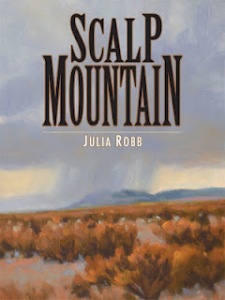Book Review — Scalp Mountain
By Rich Weatherly, "Welcome to my Place" blog.
Scalp Mountain is historical fiction and I’m a big fan of this genre. Before writing this story, author Julia Robb did extensive research about the history and geography of the region. It shows.
That said, this book has much in common with literary fiction. Throughout most of the story we see the vast expanse of the southern plains, the Guadalupe and Davis Mountains, Rio Grande River and surrounding territory. Julia Robb uses vivid, lyrical prose to show us this landscape. While reading, I was transported back to the 1870s. Her writing takes readers on a ride where they experience the story through all their senses; sight, sound, touch, smell and mental imagery through the use of beautiful word pictures.
Unlike romanticized Hollywood westerns of our parents’ time, in this story you’ll find good and bad on all sides. These truly are three dimensional characters; characters based in the realities of life, not cowboys in white hats and villains in black.
Characters define this story and lead us through the plot. In these characters we see complex personalities. Most of the story is presented through the eyes of the protagonist, Colum McNeal. Colum faces life and death situations from multiple characters who would love to kill him. He understands the motivation of two of them; revenge. Another, long time acquaintance, Mason Lohman is a mystery to him.
Julia Robb relies heavily on inner dialog. You’ll spend almost as much time inside these characters heads as you do watching the action taking place around them. There is a powerful psychological feel to the story.
That said, there are well executed fight scenes; those between individuals and between larger groups; from gun battles to knife fights, you’ll be at the center of the action in these fast paced, rapidly changing scenes.
Julia will help you see touching emotions from many of the characters; not just the protagonist. Much of the story is centered on pioneer settlers and their Native American rivals; other parts between Texas Rangers and theU.S. Cavalry. You’ll get a balanced, realist portrayal of each. Clementine Weaver, the wife of one of Colum’s neighbor, has adopted an Apache orphan. This orphan child is the son of José Ortero, a Jacarilla Apache and at one point we see his love for the child. Column is drawn to her as she nurses him through recovery after a brutal attack. His feelings become much more than sentimental.
Mankind has a history of brutality during war. Scalp Mountain doesn’t look the other way when it comes to violence. These scenes of gruesome violence will make you shudder at the harsh realities we humans foist upon one another. Atrocities occurred upon and from each of the opposing groups.
You’ll find things about the white pioneers and the Apaches you admire. I think you’ll come away with a fuller, richer understanding of the real dynamics of the late 1800s in West Texas.
The author has done thorough research and that research has paid dividends in this well written story about difficult times and circumstances.
